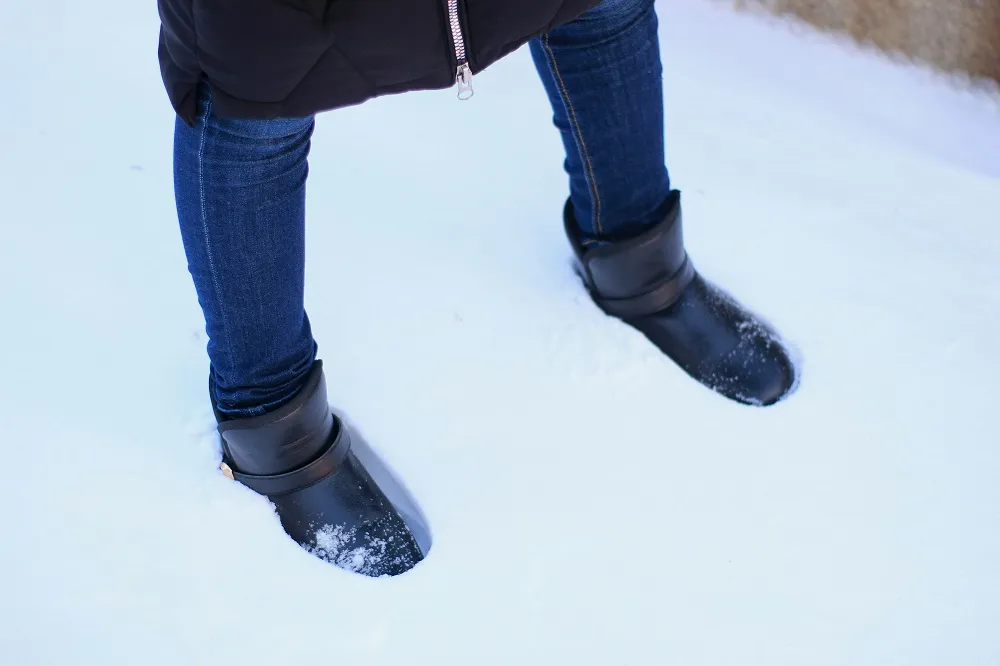Today I will tell you a story about the cold. Yes! A cold that feels very different. I felt a different kind of cold in Iceland last February. I will also share what to wear in Iceland in February when traveling there. I thought I knew cold. I was wrong. Iceland’s cold is different. It is a mix of wind, water, and ice. But I learned how to beat it. And I had the most amazing adventure of my life.
In Iceland, February is cold, with temperatures between –1°C and 4°C. Snow, rain, and strong winds are common, so the right clothing is essential.
The best way to stay warm is layering—a thermal base, a warm middle layer, and a waterproof coat on top. This system keeps you comfortable in changing weather.
A thick winter coat, waterproof pants, and insulated boots are must-haves for outdoor adventures. Add a hat, gloves, and a scarf, and you’ll be ready to enjoy Iceland’s stunning winter landscapes without freezing.

Understanding Iceland’s February Weather
February in Iceland is a blend of wintry weather surprises. Temperatures hover between -1°C to 4°C. The mix of snow, rain, and wind creates a unique climate challenge.
Expect rapidly changing conditions throughout the day. Sunny moments can suddenly turn into windy snow showers. This requires flexible clothing choices and preparedness.
Here’s a quick summary of the typical February weather:
- Temperatures: -1°C to 4°C (30°F to 39°F)
- Conditions: Snow, rain, and strong winds
- Daylight: Approximately 7-9 hours
Understanding this weather helps you plan your wardrobe effectively. Staying warm and dry ensures you’ll enjoy all that Iceland offers during this frigid month.
The Layering System: Staying Warm and Dry
The key to comfort in Iceland’s unpredictable February weather is layering. This method keeps you warm and adapts to sudden weather shifts. It involves wearing several layers of clothing, each serving a unique purpose.
Start with a thermal base layer. This layer is closest to your skin and should wick away sweat. Materials like merino wool or synthetic fibers excel in keeping you dry and comfortable.
Next, add a warm middle layer like a fleece or down jacket for insulation. This layer traps heat, maintaining your body warmth throughout the chilly days. It’s crucial this layer isn’t bulky, allowing for flexibility.
Finally, top it off with a waterproof, windproof outer layer. Jackets and pants made from Gore-Tex or similar materials block wind and repel moisture. They’re vital for braving Iceland’s wet, blustery conditions.
- Base Layer: Thermal, moisture-wicking
- Middle Layer: Fleece or down for insulation
- Outer Layer: Waterproof and windproof
Embrace the layering system to stay warm and dry, ensuring a memorable Icelandic adventure.
Essential Outerwear for Iceland in February
When venturing through Iceland in February, choosing the right outerwear is critical. A quality winter coat stands between you and the harsh cold. This coat should be insulated, ensuring it retains body heat during your outdoor adventures.
Also, seek a coat with a sturdy hood to guard against rain, snow, and wind. A hood with a drawstring can be adjusted for added protection. Remember, keeping your head dry can significantly enhance your warmth.
Don’t forget waterproof pants, especially if you’re planning any activities like hiking or exploring waterfalls. They will shield you from the wet conditions and keep you comfortable throughout your outings.
- Insulated winter coat with hood
- Waterproof, windproof outerwear
- Durable waterproof pants
Stay warm and dry with these essential outerwear items, ready for the varied weather Iceland has in store.
Must-Have Accessories: Hats, Gloves, and More
Accessories are crucial for combating Iceland’s February chill. A warm hat is essential to conserve body heat. Choose one that covers your ears well.
Gloves should be both insulated and waterproof. They guard against icy winds while ensuring your hands remain warm. Mittens are a great choice if you are prone to cold fingers.
Don’t overlook scarves or neck gaiters. They offer additional warmth and shield your neck and face from freezing gusts.
- Warm, ear-covering hat
- Insulated, waterproof gloves or mittens
- Scarf or neck gaiter
These accessories will provide an additional layer of defense, ensuring you stay snug and comfortable in Iceland’s winter wonderland.
Footwear: Navigating Ice and Snow
Choosing the right footwear is vital for Iceland’s icy terrain. Opt for waterproof, insulated boots to keep your feet warm and dry. Good traction is key to prevent slips and falls.
Consider boots with thick soles for added protection from the cold ground. These can help you maintain your footing on slippery surfaces.
Crampons or ice cleats enhance grip on icy paths and are easy to attach to most boots. They’re invaluable for exploring Iceland’s majestic landscapes safely.
- Waterproof, insulated boots
- Thick soles for added protection
- Crampons or ice cleats for traction
Prioritize quality footwear to ensure safety and comfort as you explore Iceland’s breathtaking vistas.

What to Pack for Special Activities (Hot Springs, Northern Lights, Glacier Hikes)
Exploring Iceland in February offers unique adventures. Hot springs require a swimsuit and a quick-dry towel. The thermal waters provide relaxation after a day of adventure.
For Northern Lights viewing, prioritize warmth. Dress in layers and pack hand warmers for prolonged exposure to the cold. A tripod is essential for capturing those stunning night skies.
Glacier hikes demand specific gear. Crampons, helmets, and ice axes are often provided by tour operators. However, ensure you wear sturdy, waterproof boots and pack extra thermal layers for comfort.
- Swimsuit and quick-dry towel for hot springs
- Layers and tripod for Northern Lights
- Waterproof boots and thermal layers for glacier hikes
Packing for these activities ensures you maximize your experiences in Iceland’s captivating outdoors.
Practical Packing List: What to Take to Iceland in February
February’s weather in Iceland is unpredictable. Packing wisely is crucial to staying comfortable and safe. Start with clothing essentials, then add gear that suits your planned activities.
Clothing Essentials
- Thermal base layers
- Insulated winter coat
- Waterproof pants
- Wool or thermal socks
Gear plays a vital role in enhancing your adventure. Choose items that cater to the conditions and ensure you are prepared for anything.
Gear and Accessories
- Waterproof, insulated boots
- Backpack with rain cover
- Reusable water bottle
- Moisturizer and lip balm
Equipping yourself with these essentials prepares you for exploring both rural and urban Iceland. Being well-prepared helps in maximizing the joy of your trip.

Tips for Dressing Like a Local and Ice Dress Code Etiquette
When traveling to Iceland, dressing like a local can enhance your experience. Icelanders prioritize function over fashion, especially during winter.
Focusing on simplicity and practicality will help you blend in. Comfort is key, so choose weather-appropriate attire that allows easy movement.
Local Dress Code Tips
- Wear neutral colors and simple patterns.
- Choose durable and functional clothing.
- Prioritize warmth and comfort over style.
Understanding these dress code nuances will enrich your Icelandic adventure. It respects local customs and ensures you fit right into the environment.
Do I need sunglasses in Iceland in February?
Yes, the sun is low and can reflect on snow, so sunglasses help protect your eyes.
Should I pack jeans for Iceland in winter?
Jeans are not good for outdoor activities because they stay wet. Use waterproof pants instead.
Do I need a swimsuit in February?
Yes, Iceland has hot springs like the Blue Lagoon. A swimsuit is essential even in winter.
Can I rent winter gear in Iceland?
Yes, many shops rent jackets, boots, and crampons if you don’t want to buy new ones.
How many pairs of shoes should I pack?
One pair of waterproof boots for outdoors and one pair of comfortable shoes for indoors are enough.
Final Tips for a Comfortable Iceland Adventure
Be prepared for sudden weather changes. Keeping track of forecasts helps you adjust your clothing accordingly. Iceland’s weather can change quickly, and preparation is crucial.
Stay flexible with your plans. This allows you to embrace unexpected opportunities or avoid weather disruptions. A flexible mindset maximizes your Iceland adventure, enhancing your travel experience.






